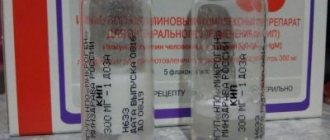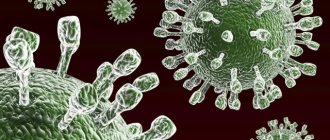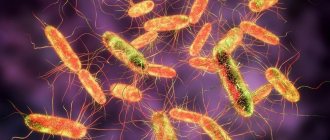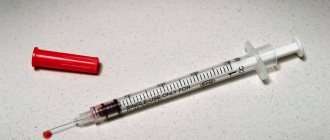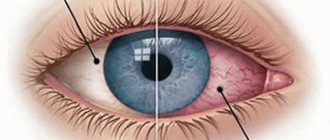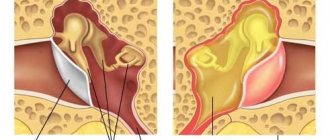All food and water that people consume, unfortunately, are very far from sterile. Every day and every hour, billions of different bacteria enter our bodies. Nothing bad happens from this, because nature has come up with effective ways to neutralize microbes. “Good” bacteria, saliva with bactericidal properties, and poisonous gastric juice do not allow foreigners to take root in the body and destroy it.
But a child’s body is very delicate and receptive, so miracles do not always happen to him. Unfortunately, says Dr. Komarovsky, intestinal infections happen to children with almost the same frequency as ARVI. What should parents do if they suspect their toddler has an intestinal infection, and are there ways to prevent dangerous infection? Let's try to figure this out.
Symptoms
General symptoms
- Pain syndrome. Depending on the level of intestinal damage, pain can be localized in the upper or lower abdomen.
- Diarrheal syndrome. Most intestinal infections are characterized by increased frequency of bowel movements, which is often accompanied by the appearance of false urges - tenesmus.
- Constipation. In severe cases of the disease, intestinal paresis may develop, which is externally characterized by persistent constipation that persists for several days.
- Change in stool character. In most cases, the stool becomes liquid, watery, and its color changes. Residues of undigested food, mucus or blood may be found in the stool.
- General intoxication of the body. An intestinal infection is necessarily accompanied by a deterioration in the patient’s general condition, which is manifested by the occurrence of fever, general weakness, headaches, weight loss, and lack of appetite.
- Nausea and vomiting. Depending on the severity of the disease, vomiting can be single or repeated, bring relief to the patient or, conversely, worsen his condition.
| Intestinal infection | Specific symptoms |
| Botulism |
|
| Salmonellosis |
|
| Dysentery |
|
| Escherichiosis |
|
| Typhoid fever |
|
| Paratyphoid infections |
|
| Rotavirus infection |
|
| Adenovirus infection |
|
| Enterovirus infection |
|
Treatment of an intestinal infection depends on what pathogen is causing it, however, a number of general rules can be identified that apply to all lesions of the digestive system.
In mild cases of pathology, the patient is prescribed a gentle diet. The total volume of food is reduced, foods harmful to the intestines are excluded, and the most gentle nutrition is prescribed. In moderate to severe cases of the disease, the total daily caloric intake is reduced by approximately 40-50%. It is recommended to increase the frequency of meals to 6-8 times a day.
| Recommended Products | Not Recommended Products |
|
|
Drugs
Antibiotics are used to treat severe bacterial infections. The means are selected depending on the pathogen.
For milder forms of the disease, antibacterial drugs are usually not prescribed; symptomatic therapy is carried out. It includes:
- Administration of saline solutions (Trisol, Regidron). In mild forms of the disease, the liquid is prescribed orally, in severe forms it is administered parenterally.
- Antipyretics. To reduce temperature and intoxication, non-steroidal anti-inflammatory drugs (Ibuprofen, Nimesulide), as well as Paracetamol, are prescribed.
- Sorbents (Enterosgel, Polysorb, Smecta). Drugs from this group neutralize toxic substances contained in the affected intestine and remove them from the body. Thanks to this, the severity of intoxication in the body is reduced.
- Probiotics and prebiotics. Intestinal infections are usually accompanied by symptoms of dysbiosis, so patients are prescribed medications to restore the normal microflora of the digestive system. Medicines are used exclusively during the rehabilitation period, when diarrhea syndrome disappears, since before this their use is practically ineffective.
If an intestinal infection is suspected, the patient must assess his condition and decide on treatment tactics. If this is mild food poisoning, which is not accompanied by a pronounced rise in temperature and extraintestinal symptoms, then the disease can be treated at home. For this, hunger and rest, plenty of drinking, and the use of sorbents are recommended.
The prognosis for the patient will depend on the causative agent of the intestinal infection. In most cases, the disease is easily eliminated, but in some specific diseases the disease is accompanied by complications and can even lead to death. The key to a favorable resolution of the disease is early consultation with a doctor and compliance with his instructions.
Doctors say that it is almost impossible to avoid the invasion of pathogenic microorganisms. Every day a person encounters many different viral and bacterial agents. Constant attacks of the latter can only be repelled by a strong immune system. Not everyone has one. Intestinal infection in adults manifests itself in serious conditions.
Medical practice shows that bacillation can develop as a result of invasion of various pathogens. Each of them has poisonous biologically active substances. For this reason, if you have an intestinal infection, symptoms and treatment in adults are directly dependent on the species of the microbe.
- dysentery;
- cholera;
- salmonellosis;
- Escherichiosis;
- adenovirus;
- rotavirus;
- enterovirus;
- norovirus;
- halophilesis;
- campylobacteriosis.
Symptoms of the disease appear gradually. The incubation period of intestinal infection, or the latent (hidden) phase of infection, depends on the type of pathogen. As a rule, the microbe needs 3-5 days to get comfortable in the intestines. At the same time, the incubation period can pass in a shorter time - 1-2 days.
Diarrhea is the most dangerous manifestation of infection. In this case, an important factor in the fight against the disease is replenishing lost fluid. It is known that dehydration can have negative consequences. As a result, if the patient has severe symptoms, he needs urgent hospitalization.
- Intoxication, which are expressed in the following conditions:
- nausea;
- weaknesses;
- dizziness;
- temperature increase;
- confusion;
- body aches;
- headache.
- Gastritis, accompanied by the following syndromes:
- Enteritis, which are characterized by frequent loose stools (diarrhea).
- Colitic symptoms are accompanied by inflammation and pain in the intestines.
The disease occurs against the background of microbial invasion. For this reason, treatment of intestinal infections in adults should begin with diagnosis. Through laboratory tests, the specific causative agent of the disease and its sensitivity to certain medications are identified. When answering what to do in case of intestinal infection in adults and children, doctors recommend, first of all, to ensure the replenishment of lost fluid in the patient’s body.
Therapy for pathogenic invasion is carried out taking into account the patient’s age and concomitant diseases. Treatment of acute intestinal infection in an adult is practically no different from the measures taken in relation to an infected child. The only difference is in the dosage of the prescribed medications.
- antibiotics (Norfloxacin);
- enterosorbents (Enterosgel, Atoxil, Smecta);
- H2-histamine receptor blockers (Omez, Ranitidine);
- enzyme preparations (Creon, Mezim);
- antiemetics (Cerucal);
- lactobacilli and bifidobacteria (Enterol).
Antibiotics
- Isolation of the pathogen and its antigens (toxins) from the blood
- Bacteriological research: isolation and typing of the pathogen in cultures of stool, other biological secretions and excreta of the patient’s body
- Virological research: isolation of the virus from stool in cell culture or by electron microscopy
- Microscopic examination: detection of parasites in smears of native feces after treatment with special dyes
- Detection of serum antibodies to pathogen antigens and the increase in their titer: serological examination using special diagnostic tests (RPGA, RIGA, ELISA, etc.); titer increase 4 times.
- combating the pathogen (antibacterial therapy);
- combating dehydration (as a rule, to eliminate the lack of fluid, patients are prescribed saline solutions);
- elimination of diarrhea (enterosorbents);
- following a gentle diet (excluding fresh vegetables and fruits, dairy products, sweets).
Principles of therapy
Mild infections are treated with intestinal antiseptics (Furazolidone, Intestopan, Biseptol, Enterosediva, Fthalazol). These medications destroy pathogenic microorganisms without affecting the normal flora.
Antibiotic therapy is mandatory for:
- salmonellosis, escherichiosis, dysentery, typhoid fever, cholera;
- the appearance of blood in the stool;
- immunodeficiency state;
- the occurrence of foci of inflammation not in the gastrointestinal tract;
- presence of neoplasms.
If necessary, therapy is carried out in a hospital setting.
The following are used to treat intestinal infections:
- antiemetics (Cerucal, Motilium, Atropine) – effectively eliminate nausea;
- rehydration solutions (Regidron, Oralit) – replenish the water-mineral balance;
- antidiarrheal drugs (Loperamide, Trimebutin) - normalize stool.
To restore the intestinal microflora and prevent dysbiosis, bacteriophages (Lactulose, Bactisubtil, Bifidumbacterin, Lactiale) are prescribed.
Sorbents (Smecta, Enterosgel, activated carbon) may also be recommended. They help remove toxic substances from the body.
Causative agents of intestinal infections
In addition to infectious agents from the natural environment, an already ill person can become a source of infection. By releasing a large number of pathogenic microorganisms (microbes are excreted in feces, vomit, and sometimes in urine), the patient infects objects around him, and if precautions are not taken, a chain reaction may occur in the spread of infection.
Almost all pathogens of intestinal infections are extremely tenacious. They are able to exist for a long time in soil, water and on various objects (spoons, plates, door handles and furniture). Infectious microorganisms in the external environment not only do not die, but also retain the ability to reproduce, and they reproduce most actively in warm and humid conditions. However, the most favorable environment for the development of bacteria is fermented milk and meat products.
A connection has been established between certain forms of acute intestinal infections and types of food. Thus, dysentery often occurs when consuming milk and dairy products, and intestinal infections caused by staphylococcus occur when consuming dairy products and confectionery products with cream. Yersiniosis usually develops when eating raw vegetables, salads and other plant foods.
The causative agents of intestinal infections can be both bacteria (Salmonella, Shigella, Yersinia, enteropathogenic Escherichia coli, staphylococci) and their toxins (foodborne diseases). Viruses (rotaviruses, enteroviruses, astroviruses, parvoviruses) are still in second place in terms of frequency of occurrence, but recently viral infections have become increasingly widespread. And in last place are the protozoa (giardia, amoebas, blastocysts).
After pathogens enter the human body, as a rule, there is an asymptomatic incubation period, which lasts from 6 to 48 hours - from the entry of microorganisms into the oral cavity until they enter the intestines, where they rapidly multiply. After pathogenic microorganisms have multiplied, the stage of clinical manifestations begins.
NB! If symptoms reminiscent of an acute intestinal infection appear, it is necessary to urgently contact an infectious disease specialist for the correct selection of therapy and the prevention of complications.
An acute period begins - from 1 to 14 days, at this time clinical manifestations from the gastrointestinal tract are most pronounced. As a rule, the period ends when the temperature normalizes and the leading symptom (diarrhea or vomiting) stops.
The convalescence period is at least 2 weeks, and in some cases, in the absence of treatment, up to several years. During this period, the function of the gastrointestinal tract, as a rule, is not fully restored - there may be unstable stools.
Basically, all intestinal infections occur with fairly similar symptoms. They always start suddenly. At the very beginning of the disease, severe weakness, lethargy, loss of appetite, headache, fever appear - nonspecific symptoms that may resemble symptoms of respiratory viral infections.
However, nausea, vomiting, cramping abdominal pain, diarrhea mixed with mucus, pus or blood (for example, with dysentery) soon occur; thirst and chills may also bother you. Among the clinical manifestations of the gastrointestinal tract, as a rule, the most pronounced symptoms are those associated with the affected organ:
- nausea, vomiting and pain in the epigastric region (with gastritis);
- diarrhea (with enteritis);
- vomiting and diarrhea (with gastroenteritis);
- blood in the stool and its disorders (with colitis);
- damage to the entire intestine (with enterocolitis).
One of the most unfavorable consequences of an intestinal infection is dehydration of the body due to vomiting and/or diarrhea and, as a result, disruption of water and electrolyte metabolism. The result of sudden dehydration can even be shock.
However, sometimes intestinal infections may not have visible symptoms, but are accompanied by the release of pathogens. In terms of the spread of infection, such carriage is the most dangerous: an unsuspecting person becomes a constant source of infection, infecting others.
It is important for the doctor to make a differential diagnosis between an intestinal infection and somatic diseases with similar symptoms: diarrhea associated with taking medications, acute appendicitis, myocardial infarction, pneumonia, ectopic pregnancy, etc.
Depending on the origin, all intestinal infections can be divided into:
- bacterial;
- viral;
- protozoans.
Much less often the disease is associated with pathogenic fungi.
| Bacterial infections | Viral infections | Protozoal infections |
|
|
|
What you can eat and drink - proper nutrition during an intestinal infection
The practice of abstaining from food for more than 4 hours is unacceptable. If there are no signs of dehydration, you should continue to eat.
What can you eat and drink if you have an intestinal infection:
- Start with the BRAT diet (Bananas, Rice, Applesauce, Toast).
- Gradually introduce lean meats and clean liquids
- When consuming products containing lactose, be aware of possible malabsorption problems.
- Infants should continue to be breastfed even while sick.
- For dehydrated adult patients and formula-fed children, the primary goal should be to restore fluid balance within 2-4 hours.
worldgastroenterology.org
Routes of transmission of intestinal infections
What diseases are intestinal infections and how can you get them? This question, at first glance, is simple, but many, confusing infections with poisoning, cannot give an accurate answer to it and recognize a life-threatening condition in time.
Intestinal infections include a large number of different diseases. Some of them occur in an acute form and pose a danger to the patient, while others pass safely and quickly.
The main route of transmission of intestinal infection is fecal-oral. A person can become infected from a sick person or from someone who has recently had the disease. Sometimes, in the period after an illness, people remain carriers of bacteria and are dangerous to others.
An outbreak of intestinal infection can develop in people who eat food prepared by an infectious person. Bacteria get into food through hands not washed after using the restroom.
Each type of intestinal infection has its own characteristics in the routes of transmission and spread among the population. Pathogens can spread not only from person to person. Some foods are natural reservoirs for them.
Below are the main types of intestinal infections and the characteristics of their transmission to humans.
Dysentery
Dysentery, or the disease of dirty hands, is an infectious disease that is widespread throughout the planet.
. Caused by Shigella bacteria. You can become infected from a sick person, as well as by drinking contaminated water, unwashed vegetables or fruits.
Outbreaks of dysentery are common in the summer. People may swallow contaminated water while swimming in ponds. The mentality of our people allows them to relieve themselves while swimming, thereby exposing other swimmers to the risk of infection.
Salmonellosis
This intestinal infection is very insidious. Often
. You can become infected with salmonellosis by eating eggs, dairy and meat products, and sausages. At the same time, the food consumed can be fresh and of high quality, and not have any abnormal smell or taste.
Most often, a person becomes infected with salmonellosis by consuming chicken or duck eggs from infected birds. At the same time, the eggs are no different from normal ones; it is impossible to suspect infection without laboratory tests.
Cholera
This intestinal disease is one of the most dangerous.
Fortunately, in our time it does not happen often, its episodes are isolated. Cholera epidemics most often develop in the summer.
You can get sick by drinking contaminated water or swimming in bodies of water. A sick person can infect others while preparing food with dirty hands. Vibrio cholerae can be carried by flies.
Rotavirus
popularly called "stomach flu" because
Rotavirus is a seasonal disease, and its outbreaks most often develop in the autumn-winter period.
You can get infected from a sick person.
This infection is transmitted by the fecal-oral route.
Enterovirus
Enterovirus outbreaks are very common. This pathogen can be transmitted from person to person.
It can also accumulate in soil and food products. The virus can remain active for a long time while remaining on personal hygiene items.
A person who has had an enterovirus infection is dangerous to others for a long time and may remain a carrier of the infection for a certain period.
- Nutritional path. Infection occurs through consumed food. This transmission mechanism is most typical for intestinal infections.
- Waterway. Microorganisms enter the human body when drinking water from untested sources.
- Contact and household path. The spread of bacteria occurs through household items.
- Airborne path. Most rarely, microorganisms enter the human body after inhaling air that contains particles of sputum from an infected patient. For intestinal infections, aerosol transmission is practically not typical, but in exceptional cases such infection is possible.
How is intestinal infection transmitted?
Gastrointestinal tract infections are transmitted from person to person through direct or indirect contact, through the fecal-oral route.
Direct contact means physical touching of body surfaces between an infected person and a susceptible person, without any barriers. Transmission can also occur indirectly, through intermediate infected objects.
Since the infection is not always transmitted directly, current evidence suggests that in the case of small round viruses (e.g. Noroviruses), infection can occur through droplets suspended in the air (e.g. during active vomiting or heavy contamination of the environment with vomit or fecal matter)
picnet.ca
Diagnostics
The main direction of therapeutic tactics is the neutralization of exotoxins in the intestines (enterosorbents) and rehydration - compensation for pathological losses of fluid and electrolytes with specially developed glucose-saline solutions. The volume of injected solutions depends on the degree of dehydration and body weight of the patient, and the injection rate is 1–1.5 l/h. Detoxification and rehydration therapy can be administered orally in 85–95% of cases.
Antibiotics can only be prescribed by an infectious disease specialist, taking into account the laboratory tests performed and the identified causative agent of the infection. However, in case of severe diarrhea, for accelerated sanitation, it is justified to prescribe antibacterial drugs that are not absorbed or poorly absorbed from the intestine and have a wide spectrum of action (for example, enterofuril or co-trimoxazole).
Enterosorbents and probiotics are effective means of alternative etiotropic therapy as drugs for acute intestinal infection. The etiotropic effect of probiotics is associated with pronounced antagonistic activity against all pathogens of acute intestinal infections (AIE) of bacterial etiology and an indirect immunomodulatory effect on the local immune system.
If an intestinal infection is suspected, the patient should contact his or her physician. After the examination, the doctor will be able to suggest a specific diagnosis and prescribe treatment. In severe cases of the disease or if a specific infection is suspected (for example, dysentery), the patient is sent to a specialized infectious diseases hospital for specialized therapy and provision of the necessary isolation.
To confirm the diagnosis of intestinal infection, the following diagnostic methods are used:
- Stool examination. The coprogram makes it possible to examine stool, detect possible impurities of blood, immune cells, isolate bacteria and send them for culture.
- Bacteriological examination of stool. Culture of biomaterial obtained from a patient is the main way to determine the causative agent of the disease. Bacteria are cultivated on special nutrient media and carefully examined, which makes it possible to establish the type of pathogenic bacterium. In addition, after identifying the pathogen, it is tested for sensitivity to antibiotics, which makes it possible to accurately select effective therapy for the patient.
- Serological studies. An additional diagnostic method is to test for antibodies in the patient’s blood. They are released in response to exposure to bacteria after 4-5 days. Antibodies have high specificity for a particular bacterium, making it possible to determine the type of microorganism.
List of effective drugs
When treating children, specialists use tetracyclines, cephalosporins, and penicillins. Antibiotics from other groups may also be recommended.
The list of the latter is quite extensive:
- Furazolidone is an antibiotic belonging to the nitrofuran family. Produced in the form of tablets, granules to create a suspension and powders. Prohibited for use in children under 1 year of age;
- Phthalazole – refers to sulfonamides. There is only one release option - tablets. Prescribed for children over 3 years of age;
- Ersefuril is a nitrofuran antibiotic. Not prescribed for newborns under 28 days of age. Available in two versions: suspensions and capsules;
- Intetrix is an amoebicidal agent. Allowed for children over 14 years old. The medication is produced in capsules;
- Biseptol is a sulfonamide antibiotic. Sold in the form of a ready-made solution, powders for injection, tablets. The medicine is prescribed to children from 2 months.
Drugs from the penicillin group include Monomycin and Ampicillin. The first is prescribed to children after 1 year, the second - from 1 month.
Tetracycline group drugs:
- Tetradox is an antibiotic produced in ampoules. Prescribed for children over 9 years old;
- Doxal is not prescribed to children under 8 years of age, as it forms specific insoluble chemical compounds in bones and tooth enamel. An intestinal antibiotic for children is produced in the form of powder for injection, tablets and capsules;
- Vibramycin - prescribed after the child reaches 8 years of age. Produced in tablet form;
Drugs of the cephalosporin group are produced mainly in the form of powders for the preparation of solutions for intramuscular administration.
Basic:
- Rocephim - can be prescribed from birth;
- Claforan - not prescribed for children under 2.5 years of age;
- Ceftriaxone - allowed from birth.
Antibiotic therapy for acute intestinal infections in children is necessary in 20% of all cases and is prescribed if the causative agent of the inflammatory process is of bacterial origin. In case of viral pathology or food poisoning, such drugs are not used.
Vodka with salt for intestinal infection
Alcohol consumption can disrupt the functioning of all parts of the gastrointestinal tract. In the small intestine, alcohol inhibits the absorption of many nutrients.
Acute alcohol consumption damages the lining of the upper small intestine and can even lead to destruction of the tips of the villi.
This leads to the release of potentially toxic cytokines by the body, which have a variety of damaging effects on membranes and the microvasculature.
The consequence of this may be damage or even death of liver cells and other organs.
Alcohol can also make vomiting symptoms worse, causing even greater loss of electrolytes, especially potassium.
Low potassium levels and increased alcohol toxicity can lead to abnormal heart rhythms (arrhythmias), severe dehydration, loss of consciousness and respiratory depression, which can be a life-threatening condition.
Therefore, it is not recommended to drink alcohol during or after intestinal poisoning.
pubs.niaaa.nih.gov
Complications
In children with any form of intestinal infection, the body is weakened, the intestinal microflora is disrupted, and the threat of dehydration increases. Massive loss of fluid not only negatively affects general well-being, but can also lead to death, so the primary medical task is to restore the water and electrolyte balance in the patient’s body. Doctors recommend taking measures even before the ambulance arrives - giving the child more fluid. If a problem occurs in a baby, it is better to dose water in teaspoons.
The acute stage is accompanied by severe vomiting, diarrhea up to 15 times a day, pain in the epigastric zone (in the area above the navel) and symptoms of general intoxication. Mass poisoning of internal organs with decay products of bacteria and viruses is the most unfavorable outcome of poisoning. Toxins produced by pathogenic flora damage the kidneys and negatively affect the nervous system.
Articles on the topic
- Diseases of the urinary system - signs, types and treatment
- Intestinal diseases - symptoms, manifestations, the most common diseases and their therapy
- Signs and how to treat dysbiosis in a child
Treatments
To reduce the risk of foodborne and waterborne infections, avoid eating undercooked meats, seafood, and water from contaminated sources when traveling.
The main goal of adequate rehydration is to replenish electrolytes.
A similar solution can be made at home by adding 1 teaspoon of salt and 4 teaspoons of sugar per liter of water.
How to treat diarrhea:
- Absorbents (Attapulgite, Aluminum Hydroxide, etc.) help patients control the time of bowel movements, but do not reduce the duration of the disease or reduce fluid loss.
- Antisecretory drugs (Bismuth subsalicylate) have antisecretory, antimicrobial and anti-inflammatory effects.
- Antimotility agents (Imodium) act on the intestinal muscles, increasing the time that electrolytes and fluid remain in the intestines. Do not use in patients with fever, systemic intoxication, bloody stools or in patients without effects after their use.
A cholera vaccine is available but provides protection in only 50% of immunized individuals for 3 to 6 months, so it is not widely used.
In 2006, an oral vaccine against rotavirus (RotaTek) was developed in infants. The vaccine is given in three doses starting from 6-12 weeks of age and ending at 32 weeks of age. Clinical studies of the vaccine showed effectiveness in preventing 74% of cases of rotavirus gastroenteritis among all severe forms of gastroenteritis and almost all hospitalizations.
In April 2008, Rotarix, another oral vaccine to prevent rotavirus gastroenteritis, was approved.
Dried fruits compote
In case of severe diarrhea or vomiting, it is recommended to take pharmaceutical drugs to replenish fluid in the body: “Regidron”, “Reosolan”, “Hydrovit”.
They are available in powder form, which must be diluted in warm water before use. The dosage is 10 ml/kg of body weight per hour, that is, an adult with a body weight of about 70 kg should drink 0.7 liters of solution within an hour. When the condition improves slightly, the dosage is reduced by half and the solution is drunk only after bowel movements or another attack of vomiting.
Rehydration products are used for all types of intestinal infections.
Antibiotics
Antibiotics are used in the treatment of bacterial infections, and only as prescribed by a specialist. The action of each drug is aimed at a specific type of microorganism, so you first need to identify the causative agent of the disease. Correct use of antibiotics gives noticeable results already on the first day of treatment, but it is impossible to stop taking them before the time specified by the doctor. The bacteria remaining in the body will become resistant to the drug and provoke an acute relapse, which will be more difficult to combat.
Rules for taking antibiotics
The most effective antibiotics
Dehydration of a child's body
Only a small part of diseases called “intestinal infections”, treatment (Komarovsky, as a doctor with many years of experience, is convinced of this) which does not require any thought, should be carried out with antibiotics. And the rest pass without such intervention, accompanied by the baby’s immune system. After a few days, she begins to develop the necessary protection against this disease. The main task of any baby is to survive these few days. And the most dangerous risk for a child during this period is the most common dehydration, says Dr. Komarovsky. Intestinal infections cause fluid to leave the body during diarrhea or vomiting. That's why it's so important to renew it.
If mom and dad know exactly how to protect their child’s body from dehydration, then their little one will not be afraid of any intestinal infection.
Prevention of intestinal infections
Prevention of intestinal infections is measures that help protect your body from this disease. To do this you need to follow these simple rules:
- wash your hands before eating;
- do not eat sweets with cream during hot weather;
- store meat and fish in the refrigerator;
- wash fruits, berries and vegetables thoroughly;
- consume only fresh meat and milk;
- drink boiled or mineral water.
Intestinal infection is a pathological process that can affect not only adults, but also children. This disease can be eliminated if you strictly adhere to the treatment regimen drawn up by your doctor.
1 — Instructions for medical use of the drug Macmiror ®
To prevent intestinal infections, it is important to regularly wash your hands and wet clean your apartment. It is better to immediately throw out expired products, do not buy them in places with unclear storage conditions - no matter how attractive, say, mushrooms from your grandmother near the metro may be - and only eat fruits and vegetables that have been thoroughly washed.
Early diagnosis and isolation of a patient with an intestinal infection will help avoid the spread of the disease. In the source of infection, you need to treat surfaces with disinfectant solutions and boil the dishes. Patients are discharged only after a negative result of a control stool examination. Anyone who has had an intestinal infection must undergo regular follow-up at the clinic for a month.
Simple measures to prevent intestinal infections:
- drink water and milk only when boiled
- wash vegetables and fruits with hot water and soap
- follow the rules and terms of food storage
- wash your hands before eating
Infection occurs through nutritional means, so the most important preventive measure is simply washing your hands. No specific measures for the prevention of gastrointestinal infections are currently used. As a result, experts strongly advise closely monitoring the freshness of food products and the time of their heat treatment. In addition, the prevention of intestinal infections includes the following nonspecific measures:
- abstaining from swimming in open water;
- storing food in the refrigerator;
- maintaining hygiene;
- thorough heat treatment of meat and poultry products;
- washing dirty hands;
- refusal to drink raw water.
- wash your hands regularly before eating;
- consume meat and dairy products from proven sources;
- do not drink water from natural reservoirs, do not swim on unofficial beaches;
- wash fruits and vegetables thoroughly, even before heat treatment;
- observe the rules of personal hygiene, do not use other people’s personal belongings (for example, towels);
- If possible, limit contact with people who have signs of intestinal infections.
We recommend reading:
What are prebiotics, their benefits and list of drugs
How can you protect yourself and your loved ones from this terrible infectious disease? Unfortunately,
, or 100% of current prevention methods. No one is immune from the development of this disease. But thanks to simple recommendations, you can reduce the risk of its development to a minimum.
Below we have collected tips for you that will help in preventing intestinal infections:
- Practice good personal hygiene and always wash your hands before eating, even before a small snack.
- Store meat products and eggs only in the refrigerator, separate from prepared meals.
- Buy products only from licensed markets or stores. Avoid spontaneous bazaars.
- Do not eat cream cakes during the hot season. At this time, the risk of developing an infection there increases significantly.
- Don't buy street food. Very often, when preparing it, basic hygiene is not observed and all sanitary standards are violated.
Intestinal infections are dangerous diseases and can be contracted from a sick person. When the first symptoms of the disease appear, you should seek medical help. Self-medication is a dangerous and thoughtless act that can lead to serious consequences. There is no need to search on the Internet for how to treat this disease; you should immediately contact qualified specialists.
Children's intestinal infections
Intestinal infections in children occur for the same reason as in adults (damage from pathogenic organisms). They primarily damage the digestive tract and are accompanied by a toxic reaction of the body.
Intestinal infection in children, like all other infectious diseases, occurs suddenly. Even in the first stages of the disease, children are visited by weakness, poor appetite, headache, and fever. At first glance, all the presented signs indicate an acute respiratory infection. But after some time, the child experiences nausea and vomiting, cramping abdominal pain, diarrhea, and chills.
Self-medication or professional experience?
But parents should not be scared and despair. This rotavirus intestinal infection is not the worst thing that can happen to their baby. Komarovsky claims that over 90 percent of all cases of intestinal infections can be overcome without the use of special medications. But the remaining 10% are the most insidious and terrible. This is exactly the case when self-medication should under no circumstances be used! The most important thing in this situation is to bring the baby to infectious disease specialists as soon as possible.
Acute intestinal infection
Acute intestinal infections are a type of infectious acute pathologies that arise as a result of the influence of various pathogenic agents. Acute intestinal infection manifests itself as fever and contributes to the development of further dehydration. Acute infection is especially severe in children and people of retirement age. The incubation period of the pathology lasts from 5 hours to two days.
Very often, salmonellosis begins acutely after a short feeling of discomfort in the abdomen. During this period, the patient notes the following symptoms of acute intestinal infection:
- weakness;
- feeling of nausea;
- vomit;
- increased temperature (38–39 C);
- acute intestinal infections are accompanied by painful sensations in the abdominal area, which are diffuse in nature;
- diarrhea, which is characterized by copious, watery, greenish bowel movements.
If a patient exhibits these symptoms of an acute intestinal infection, he must be hospitalized immediately. This form of intestinal infection is very often diagnosed in infants. Therefore, if you find green diarrhea or a rise in temperature in your baby, you should immediately show him to a specialist.
Main diseases during infection
The inflammatory process is called “dirty hands disease.” Infection occurs through the fecal-oral route (due to consumption of insufficiently well-washed vegetables and fruits, contaminated water, improperly stored food), or through household contact (when a child interacts with sick animals or people).
When pathogenic microorganisms enter the body, the following most often develops:
The main symptom of acute intestinal pathologies in children is diarrhea.
Intestinal flu (rotavirus infection)
Intestinal infections of this form occur due to the presence of rotaviruses in the body. The irritation process occurs through food, water and hands. Rotavirus infection begins to form after bacteria have invaded the cells of the mucous membrane of the small intestine. As a result, his motor activity increases, which contributes to feelings of nausea, vomiting and diarrhea.
The disease begins to manifest itself even before the viruses multiply in the required quantity to cause intestinal irritation. This is the incubation period, its duration is about 5 days.
